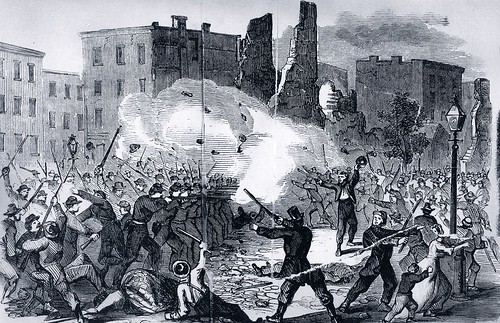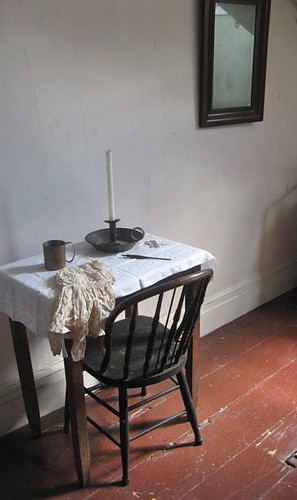 Library of CongressThe draft riots of 1863 from a contemporary publication.
Library of CongressThe draft riots of 1863 from a contemporary publication.The City of New York has known the influence of many powerful men, one of whom was a man of the cloth named Archbishop John Hughes. He had, since his arrival in 1838, aligned himself with the unassimilated Irish immigrants in lower Manhattan. This Ulster-born prelate rallied them in the face of abject discrimination, (such as “No Irish Need Apply,”) yet played on their fears whenever he could. Hughes was highly ambitious, and gladly courted controversy in the press. His letters to the editor were always signed with a cross, which with a flick of his pen looked a whole lot more like a knife. And because of his fearful countenance and violent temper, reporters began to call him “Dagger” John Hughes.
That Hughes himself was a deeply bigoted fellow would not be a difficult point to prove. He regularly published his racist diatribes, and exhorted his disdain for abolitionists in numerous sermons. He whipped up his largely Irish congregation with dire warnings of freed black slaves traveling north to steal their jobs, and they heeded his every word.
By 1861, even Abraham Lincoln was terrified of Hughes, and courted his favor at the outbreak of war. He dearly wanted the “Fighting Irish” on the side of the Union, and Dagger John was flattered that Lincoln would call on him with hat in hand. He therefore wrapped himself in the flag and bid his parishioners to do the same.
Read more…
 Graphic by Tim Milk
Graphic by Tim MilkThe Merchant’s House Museum, at 29 East Fourth Street, is hosting two star attractions this season. The first, to commemorate the 150th anniversary of the onset of the Civil War, is “Medical Photography from The Burns Archive.” It features photographs of Civil War casualties, meticulously documented through the war years by Dr. R. B. Bontecou, as well as a genuine army surgeon’s operating kit, complete with amputation knife. It is chilling to see the destructive effect of the period weaponry on the soldiers, corpsmen and drummer boys at the front of the lines. The Burns Collection in all its facets can be seen here.
 Tim MilkThe corner of a servant’s room.
Tim MilkThe corner of a servant’s room.Dr. Stanley Burns’ overview of Dr. R. B. Bontecou’s photographs, “Shooting Soldiers,” can be accessed at www.burnspress.com.
Secondly, the curators of Merchant’s House are pleased to open the household servants’ quarters to the public for the very first time. These are quite possibly the oldest extant immigrant Irish living quarters in the city. See the world as they did, through the attic dormers. Observe the call-bell hooked to a chord that led downstairs, which hearkened them to their duties. Living together beneath the roof as they did, the Irish women communed much closer to the elements and much farther from comfort than did the “better half.” As always, the museum is a fascinating visit to a bygone era, with original décor and furnishings dating back to the 1830’s.
“Medical Photography from The Burns Archive” runs through Aug. 1. The self-guided tour is a continuing event. For information on hours, stop by the Merchant’s House website: www.merchantshouse.com






